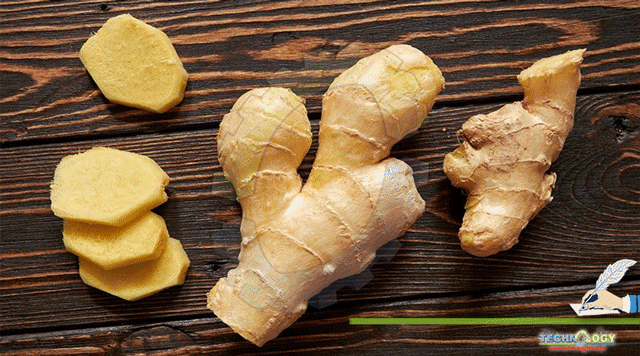It is believed to be native of South-Eastern Asia. Ginger’s current name comes from the middle English gingivere , but this spice date back over 3000 years to the Sanskrit word Srngaveram, meaning ‘’horn root.’’ Based on its appearance.

By Samra Gulzar, Athar Mahmood, Safura Bibi
In Greek it was called Ziggiberis, and in Latin, Zinziberi.
Scientific name: Zingiber officinale
Common name: Ginger
Family: Zingiberaceae
Ginger is the most commonly consumed dietry condiments in the world. It is the member of a plant family that includes cardamom and turmeric. Ginger comes from Rhizome, which is an underground stem that grows horizontally and develops root downword, while leaves as well as new stems sprout on top. Buds then develop at intervals along every single stem. Chemical analysis of ginger shows that it contains over 40 different compounds. Major constituents are Carbohydrates(50-70%), Lipids(3-8%), terpenes, phenolic compounds, amino acids, raw fiber, Ash, protein, Phytosterols, Vitamins (e.g Nicotinic acid and vitamin A) and minerals are present.
Ginger flourish best in well drained soils like Sandy loam, clay loam, red loam, or lateritic loam. Pakistan is relatively small producer of ginger, which is mainly concentrated in parts of Sindh, NWFP and Balochistan don’t produce ginger. Attempts have been made with considerable success to produce ginger in Pakistan.
It is mentioned in ancient chines, Indian, and middle easteren periodicals and has long been valued for its aromatic, nutritive, and medicinal properties. China, India, Nepal and Thiland are the major producers of ginger in the world.
Nutritional value:
Ginger is among the healthiest and most delicious species on the planet. It is loaded with nutrients and bioactive compounds that have powerful benefits for your body and brain. Warm, humid climate is the most ideal for ginger cultivation. Ginger can be grown both under dry land and irrigated conditions. It is usually cultivated vegetativly, meaning pieces of rhizome are planted in the soil and each sprout to form a new plant. Ginger root has one of the highest levels of antioxidants compared to other foods. Antioxidants prevent oxidative stress, a process that is associated with diseases like cancer, diabetes, and stroke. Oxidative stress occurs when there are too many free radicals — molecules naturally produced by metabolic processes — in the body. Antioxidants stabilize free radicals and prevent oxidative stress, thereby protecting the body from disease.
The ginger rhizome contains an essential oil and resin known collectively as oleoresin. It contains small amount of alkaloids, tannins, carotenoids, flavenoids, steroids and cardinolides. It has immense phytotherapeutic properties. Ginger contains very few vitamins and minerals. Since it is typically eaten in small quantities, people generally don’t get many nutrients from it. Unique compounds within ginger are thought to be the primary source of its health benifits. These include gingerol, shogaols, zingiberene, and zingerone.
Medicinal value:
Ginger is a common folk treatment for upset stomach and nausea. There’s evidence that it helps. Ginger seems to aid digestion and saliva flow. Studies found that taking ginger could ease nausea and vomiting in some pregnant women. But pregnant women should be careful with ginger. Some experts worry that it could raise the risk of miscarriage, especially in high doses. Ginger seems to help with nausea caused by vertigo as well. There’s mixed evidence about whether it helps with nausea caused by motion sickness, surgery, or chemotherapy. Ginger does seem to help with painful periods. In one study, more than 60% of women felt that ginger lessened pain.
Anti-inflammatory and anti-oxidant
Treat Nausia, especially morning sickness
Reduce muscle pain and soreness
Treat Osteo-arthritis
Drastically lower blood sugars and improve Heart disease risk factors
Treat chronic indigestion
Ginger powder may drastically reduce menstrual pain
Lower’s cholesterol level
Prevents cancer
Improve brain function and protect against Alzheimer’s disease.
Conventional use of Ginger:
Ginger has a very long history of use in various forms of traditional/ altenative medicine. It has been used to help digestion, reduce nausea, flue and common cold. Traditionally it is used as a botanical medicine include the treatment of inflammation, fever, toothache, indigestion, constipation, diarrhea, severe sprains, and to relieve pain, as well as antispasmodic, antirheumatic, and diuretic agents.
Modern use:
Cold induced diseases, heart paliptations, swellings, asthma, loss of apetite and rheumatism are mainly reduced by fresh ginger. In food and beverages rhizomes of ginger are used as spice. According to Anekwe, you can easily incorporate ginger into your diet by adding a few pieces of fresh ginger to hot water to make tea. You can add finely chopped fresh ginger or powdered ginger to curries or stir-fries and by Mixing a bit of ginger into your morning smoothie. You can also use this in Baking cookies, cakes, or pastries with ginger. If you don’t like the taste of ginger, you can buy capsules of ginger from your local pharmacy. While ginger is very safe, it is best not to consume more than one gram of ginger a day, or you may experience throat burn, heartburn, or gas.
Side effects of Ginger:
Increased bleeding tendency
Abdominal discomfort
Cardiac arrhythmias (if over dosed)
Central nervous system depression( if over dosed)
Diarrhea
Heart burn
Mouth or throat irritation
Bacterial wilt of Ginger is the most serious rhizome-borne disease. It is also soil and seed-borne
disease
Authors: Samra Gulzar, Athar Mahmood, Safura Bibi University of Agriculture Faisalabad